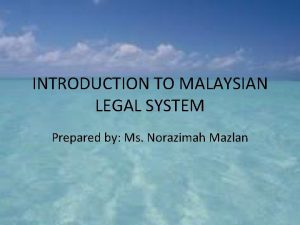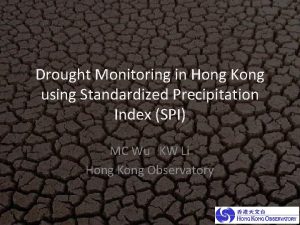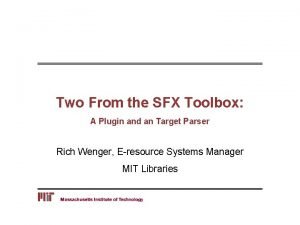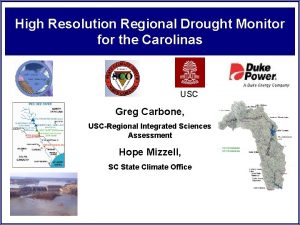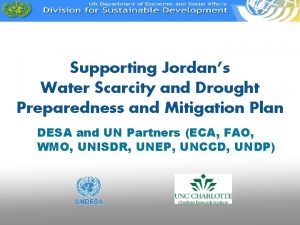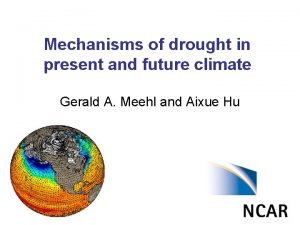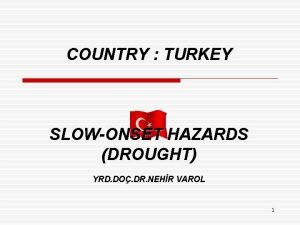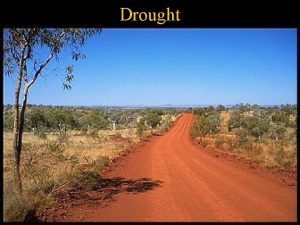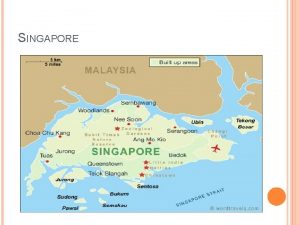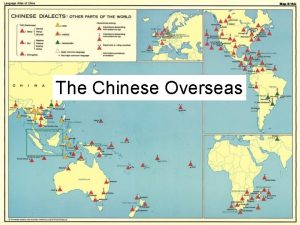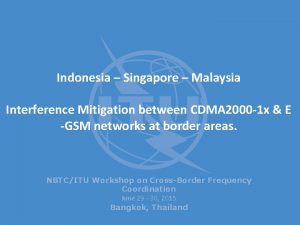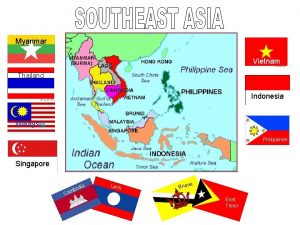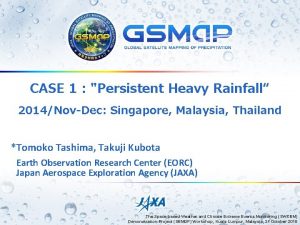CASE 3 Drought 2014JANMAR Singapore Malaysia Indonesia Tomoko











![Drought Detection Monthly mean precipitation [mm/day] January 2014 Monthly precipitation percentiles [%] ・Areas below Drought Detection Monthly mean precipitation [mm/day] January 2014 Monthly precipitation percentiles [%] ・Areas below](https://slidetodoc.com/presentation_image_h/19c6019a6bc18db5eccb728cc12f052c/image-12.jpg)
![Drought Detection Monthly mean precipitation [mm/day] February 2014 Monthly precipitation percentiles [%] In February Drought Detection Monthly mean precipitation [mm/day] February 2014 Monthly precipitation percentiles [%] In February](https://slidetodoc.com/presentation_image_h/19c6019a6bc18db5eccb728cc12f052c/image-13.jpg)
![Drought Detection Monthly mean precipitation [mm/day] March 2014 Monthly precipitation percentiles [%] In March Drought Detection Monthly mean precipitation [mm/day] March 2014 Monthly precipitation percentiles [%] In March](https://slidetodoc.com/presentation_image_h/19c6019a6bc18db5eccb728cc12f052c/image-14.jpg)





- Slides: 19

CASE 3 : “Drought“ 2014/JAN-MAR: Singapore, Malaysia, Indonesia *Tomoko Tashima, Takuji Kubota Earth Observation Research Center (EORC) Japan Aerospace Exploration Agency (JAXA) The Space-based Weather and Climate Extreme Events Monitoring (SWCEM) Demonstration Project (SEMDP) Workshop, Kuala Lumpur, Malaysia, 1 November 2018

Target and Data Target - Drought - Singapore, Malaysia, Indonesia - January - March 2014 Data Used - GSMa. P NRT Gauge (v 6) (GSMa. P_GNRT 6) • GSMa. P NRT Gauge-adjusted GSMa. P product • basis 0. 1° and 0. 25° lat/lon grid box - CPC Gauge Analysis (CPCGAG) • Grid analysis of daily precipitation produced through interpolation of GTS station reports • 0. 25° lat/lon grid box 1

Previous Study John L. Mc. Bride et al. , 2015: THE 2014 RECORD DRY SPELL AT SINGAPORE: AN INTERTROPICAL CONVERGENCE ZONE (ITCZ) DROUGHT Interannual and climate change perspective From December through March, the lowlevel flow over Singapore is Northeasterly, the “Northeast monsoon in the South China Sea. ” As shown in Fig. b, February has a different rainfall climatology than the rest of the Northeast monsoon, being considerably drier. This is associated with the ITCZ reaching its furthest southward location in that month and thus having less effect on Singapore’s rainfall. Singapore climatology showing monthly median rainfall (mm) for a network of 28 stations operational since 1980, and highlighting the climatological February dry season. 2

Previous Study John L. Mc. Bride et al. , 2015: THE 2014 RECORD DRY SPELL AT SINGAPORE: AN INTERTROPICAL CONVERGENCE ZONE (ITCZ) DROUGHT January - March 2014 The 2014 event was characterized by a two-month-long record dry period, associated with a contraction of the ITCZ in its position south of the equator, and a suppressed phase (phases 6– 8) of the MJO. The southward contraction of the ITCZ is the extreme value in the recent time series. The mechanism causing the narrowing of the ITCZ is not known. February rainfall (mm) averaged over an 8 station network since 1965. Red circles denote El Niño conditions. Black circles denote years with greater than 50% time in MJO dry phase (6– 8). Green circles denote years when the February mean location of Northern edge of ITCZ is south of equator. 3

Performance of GSMa. P_GNRT 6 in Singapore Climatology showing monthly mean rainfall (mm/day) at the nearest 0. 1° lat/lon grid box of Singapore [1. 35°N, 103. 5°E] for the duration from April 2000 to March 2018 The fact that February is a dry season around Singapore can be also confirmed with GSMa. P_GNRT 6. 4

Performance of GSMa. P_GNRT 6 in Singapore Ø Monthly mean precipitation averaged over the 18 years January February March [mm/day] The monthly precipitation in February becomes less than those in January and March over Malaysia, Singapore and a part of Indonesia. 5

Overview of target drought Animation : Daily precipitation from 1 January 2014 to 31 March 2014 The dry period over Malay Peninsula and Indonesia continues for two-month-long time since Mid-January. 6

Overview of target drought Ø Monthly mean precipitation for 2014/Jan-Mar January 2014 February 2014 March 2014 [mm/day] The ITCZ moves southward from January to February, and returns to original position in March. è The drought over a wide area over Singapore, Malaysia and Indonesia 7

Overview of target drought Ø Comparison with climatology in February Zonal mean precipitation averaged over the region from 80°E to 140°E Monthly precipitation from the tropical region to mid latitudes of the northern hemisphere in February 2014 is much less than the 18 -year mean. These results are consistent with the previous study. 8

Comparison with CPCGAG Data used: (top) GSMa. P_GNRT 6 and (bottom) CPCGAG (left) Total precipitation in February 2014 (middle) Percentage of rainy (≧ 1 mm/day) days in a month (right) Locations of reporting gauges ・Spatial distributions of GSMa. P_GNRT 6 are roughly consistent with those of CPCGAG around grid boxes including rain gauges. ・Malaysia, Singapore and a part of Indonesia are very dry condition below 10% as regards percentage of rainy days. 9

Definition of Drought SPI methodology Source: http: //www. wamis. org/agm/pubs/SPI/WMO_1090_EN. pdf Classification system shown in the SPI value table e. g. 1 -Month SPI It reflects short-term conditions, its application can be related closely to meteorological drought. 3 -Month SPI It reflects short- and medium-term moisture conditions and provides a seasonal estimation of precipitation.
![Drought Detection Monthly mean precipitation mmday January 2014 Monthly precipitation percentiles Areas below Drought Detection Monthly mean precipitation [mm/day] January 2014 Monthly precipitation percentiles [%] ・Areas below](https://slidetodoc.com/presentation_image_h/19c6019a6bc18db5eccb728cc12f052c/image-12.jpg)
Drought Detection Monthly mean precipitation [mm/day] January 2014 Monthly precipitation percentiles [%] ・Areas below -1. 2 of the 1 -month SPI is consistent with areas below 10 th percentile well. ・In January 2014, the drought has been detected mainly in Indonesia. 11
![Drought Detection Monthly mean precipitation mmday February 2014 Monthly precipitation percentiles In February Drought Detection Monthly mean precipitation [mm/day] February 2014 Monthly precipitation percentiles [%] In February](https://slidetodoc.com/presentation_image_h/19c6019a6bc18db5eccb728cc12f052c/image-13.jpg)
Drought Detection Monthly mean precipitation [mm/day] February 2014 Monthly precipitation percentiles [%] In February 2014, the drought expands over a wide area over Malaysia, Singapore and Indonesia. 12
![Drought Detection Monthly mean precipitation mmday March 2014 Monthly precipitation percentiles In March Drought Detection Monthly mean precipitation [mm/day] March 2014 Monthly precipitation percentiles [%] In March](https://slidetodoc.com/presentation_image_h/19c6019a6bc18db5eccb728cc12f052c/image-14.jpg)
Drought Detection Monthly mean precipitation [mm/day] March 2014 Monthly precipitation percentiles [%] In March 2014, though the drought area decreases, “extremely dry condition” holds at Sumatra Island etc. 13

Drought Detection Singapore, the western shore of Malaysia and most of Indonesia are detected as “severely dry” or “extremely dry” conditions. 14

Summary We examined the performance of GSMa. P NRT Gauge (v 6) for the drought event of CASE 3. Results similar to a previous research were also obtained from the GSMa. P. We tried to detect the drought in the target area using the 1 -Month and 3 -Month SPI values. It seems that GSMa. P NRT Gauge (v 6) could detect it well. è Above results indicate usefulness of GSMa. P NRT Gauge (v 6) for drought monitoring. 15

Backup Slides 16

Overview: GSMa. P_GNRT 6 Climo of January 2014 Zonal mean (80°E – 140°E) Climo of March 2014 Zonal mean (80°E – 140°E) 17

Comparison with CPCGAG Daily Monthly 6 N Locations of reporting gauges 5 S 95 E 120 E Scatter plots between CPCGAG (Y) and GSMa. P_GNRT 6 satellite precipitation (X). A result for daily and monthly precipitation from January to March 2014 are plotted in the left and right panels, respectively. The targets are a 0. 25 olat/lon grid box with at least one reporting gauge over the region (95°E-120°E; 5°S-6°N) shown in the right panel. Though the correlation coefficient is as high as 0. 77, the dispersion is somewhat large. 18
 Lempert fenestration operation
Lempert fenestration operation Tomoko uemura in her bath
Tomoko uemura in her bath Why was a merger between singapore and malaya proposed
Why was a merger between singapore and malaya proposed Malaysia malaysia malaysiansleereuters
Malaysia malaysia malaysiansleereuters Best worst and average case
Best worst and average case Sentence for drought
Sentence for drought Types of drought
Types of drought Concept of sustainable development
Concept of sustainable development Drought usaco
Drought usaco Drought presentation
Drought presentation Anasazi drought
Anasazi drought Conclusion on drought
Conclusion on drought Vermont drought monitor
Vermont drought monitor Utah drought map
Utah drought map Drought stopper system
Drought stopper system World, drought monitor
World, drought monitor Jordan drought
Jordan drought Drought present tense
Drought present tense Drought and desertification
Drought and desertification What are solutions of drought
What are solutions of drought



